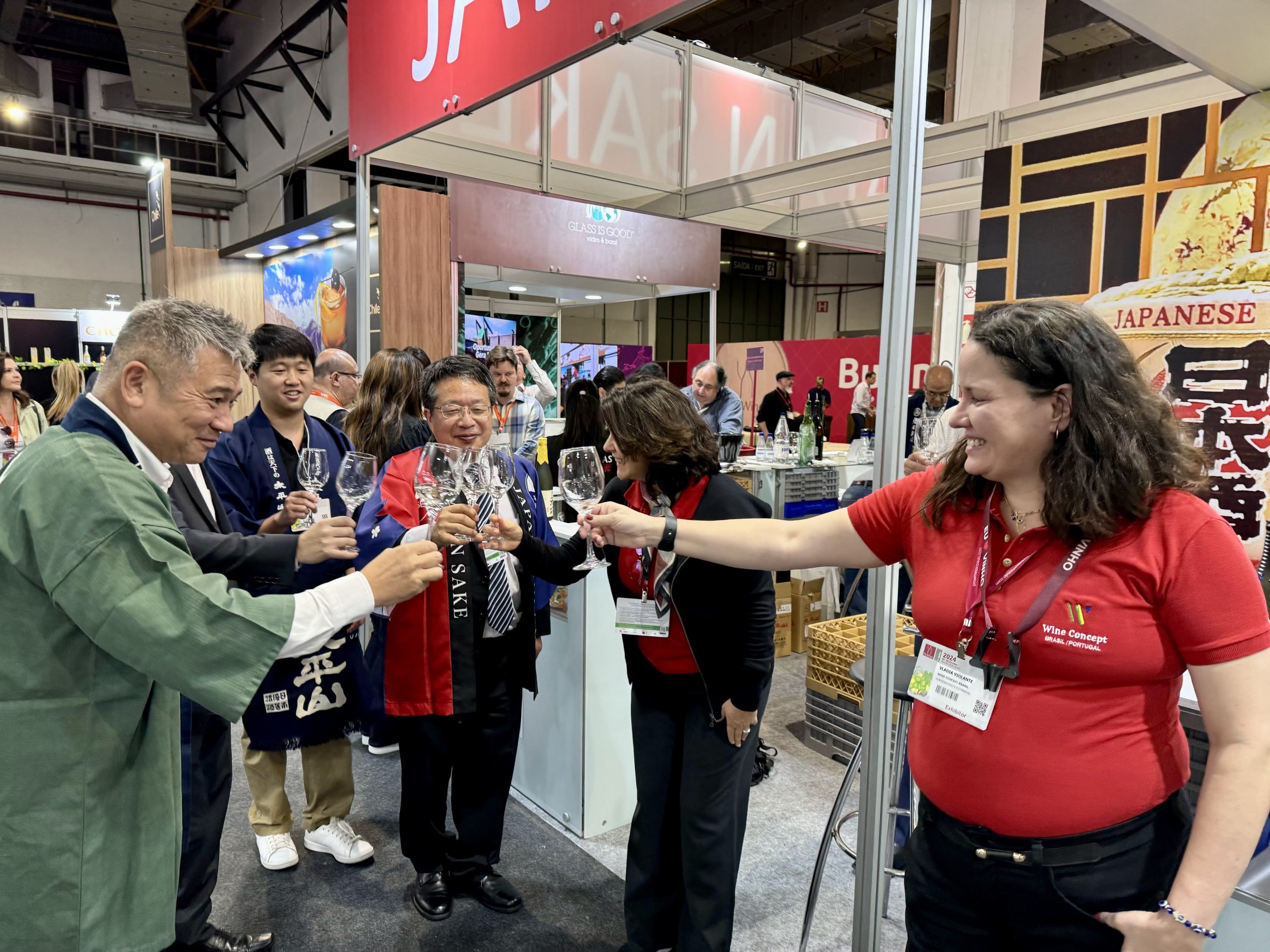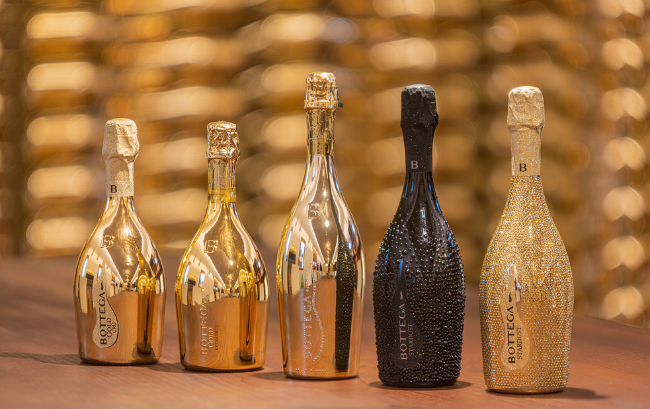Is it time to give multi-vintage still white wines a chance?
By Filippo BartolottaTen years after Pasqua Vigneti e Cantine embarked on its innovative multi-vintage white wine project, Hey French: You Could Have Made This But You Didn’t, Filippo Bartolotta tastes its third edition and asks if it is time to reassess our devotion to single vintage wines.
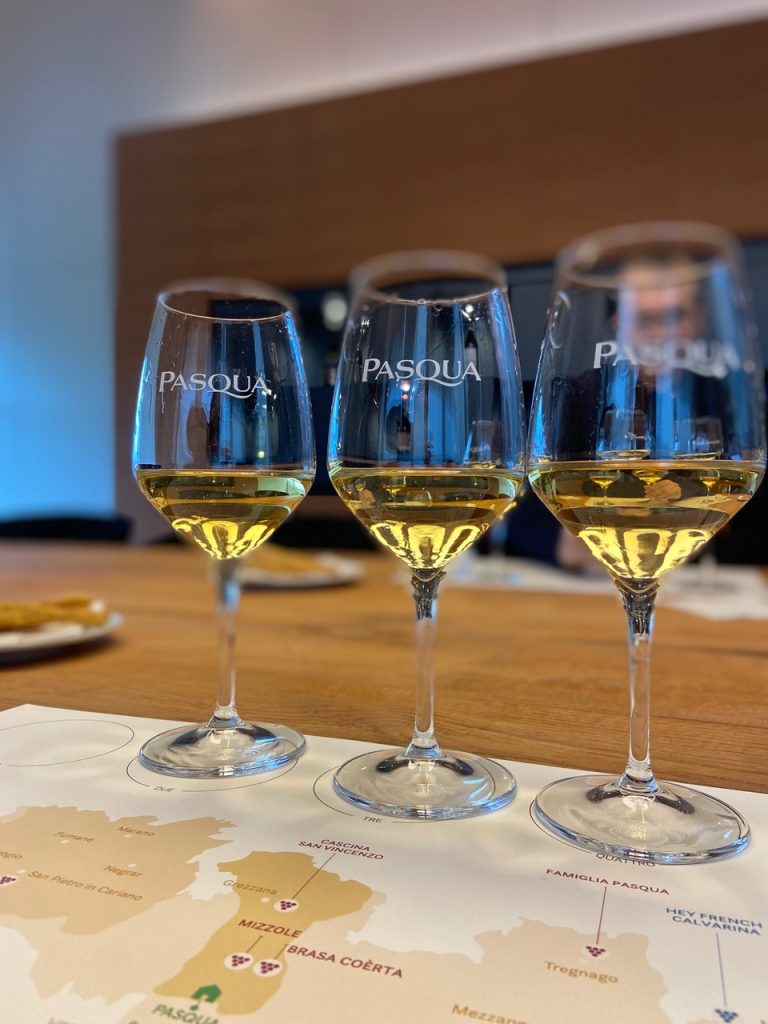
“Our dream was to create a wine outside the box, which no one had yet imagined, but with the well-defined and recognizable character of our cellar,” Riccardo Pasqua, CEO of Pasqua Vigneti e Cantine explains, of the company’s Italian multi-vintage white wine, provocatively entitled Hey French: You Could Have Made This But You Didn’t.
“We have gathered the best the vineyards of Monte Calvarina could offer, completely overturning the codes: a unique operation of its kind, but we are convinced that we have identified the right interpretation,” Pasqua explains. “The result allows us to say, with just the right touch of irony, that someone else could have done it, but hasn’t yet. We are pioneers in this experiment, and we are really proud of it.”
He explained that in 2013 they were looking for a great place to make a great white from Verona but had to go further east from Valpolicella to find an incredible vineyard in the Soave area: very high, with volcanic soil and the perfect characteristics for an exceptional product.
“But then we started the strategical and creative process and realized that we weren’t certainly going to be the first ones wanting to a great white wine here. In 2013 we had our first harvest and while taking care of this very first vintage we had the eureka moment: why don’t we wait bottling and make the first Italian multi-vintage?”
The wine’s name tells the story of the cellar’s experimentation process as well as being a declaration of intent towards the great names of the international winemaking tradition.
In addition to the agronomical and oenological research to produce the wine, Pasqua decided to take an extra step with the handing over the creation of the label to 24-years-old artist CB Hoyo, for added intrigue.
A self-taught, infant prodigy of the new course of contemporary art, CB Hoyo was born in Havana but moved to the Dominican Republic before settling in Europe. He has become known and appreciated for his ability to translate the contradictions of a present dominated by fake news and social media, by creatively questioning the authenticity of some great masterpieces of art or iconic items from the fashion world, and questioning their real market value with simple but ironic and impactful messages. It must have been the ironic and unconventional approach that conquered the vibrant “Silicon Valley-Renaissance bottega” Pasqua winery.
This year Pasqua Vigneti e Cantine is out with their third edition of the “Hey French”. So I thought after ten years from the beginning of the project it was a good time to assess the quality and the conditions of this multi-vintage white. Whether the wine kept its promises to be an Italian fine white with long aging potential with an enhanced sense of terroir. So I drove to Verona to taste and review exclusively for db readers the three editions of this very elaborate, super-white.
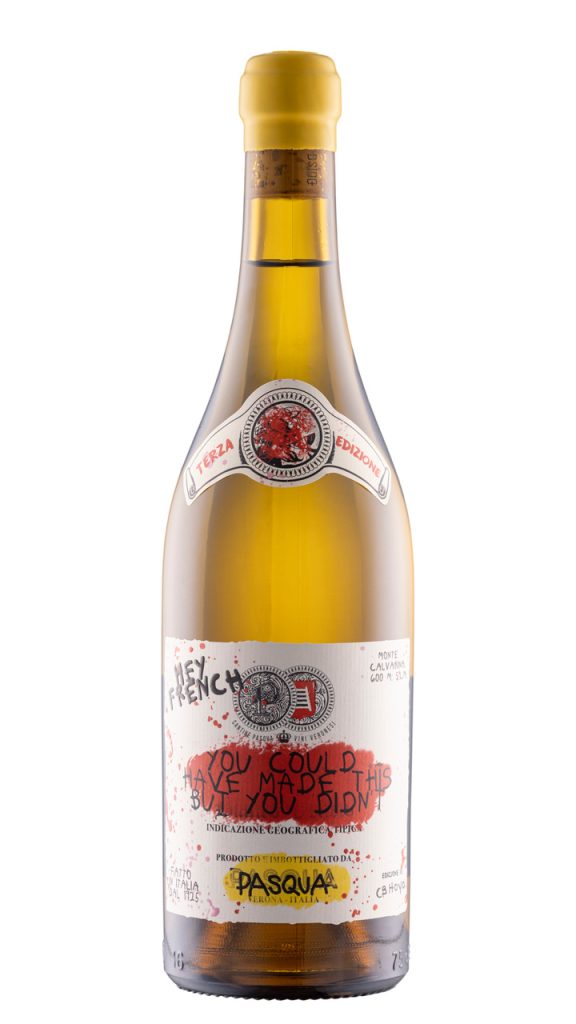
The Vineyard
The four and a half hectares vineyard plot is located at 600 meters above sea level in the highest part of Monte Calvarina in the Soave area, 50 miles east of Verona. Each of the three varieties used in the blend are situated at different altitudes and inclinations in order to arrive ready to harvest at more or less the same time. The site has a south-west exposure with some guyot and some pergola trained vines, but one of the most striking factors is the black eruptive basaltic volcanic soil which offers the best conditions to guarantee that mineral and smoky complexity beloved by many wine lovers.
Local Garganega provides the backbone to the blend, a minimum of 80-85%, which offers both structure and finesse as well as the acidity and wonderful glycerol roundness that can last for many years. This is supplemented by Pinot Bianco and Sauvignon Blanc, that bring more aromatics and suppleness to the blend. Each year the grapes are harvested and vinified at around the same time, but each vintage is then jealously preserved, waiting to potentially go into the final blend.
The Vinification
Although each edition is a little different, for each selected vintage the vinification begins with maceration on the skins for around 10 hours, followed by alcoholic fermentation at low temperatures and on selected yeasts, with subsequent partial malolactic fermentation (about 10% of the product) in barrels. The fining takes place in some new and second passage wood for around 8 months, concluded with a final assemblage in steel before bottling. Each vintage contributes for approximately 25% to the total blend.
Partner Content
But are all these efforts worth it? Weren’t we always told that single vintage wines are the best?
Single versus multi-vintage
We all have experience of the great multi-vintage and non-vintage Champagnes and sparkling wines of the world or with the great Sherry, Port or Marsala wines and have always learnt how it was a matter of consistency to balance out cold and hot vintages etc. However, vintage samples have always been considered the best – and the bad reputation of still wines with no vintage is reflected by the fact that cheap generic wines (previous referred to as ‘table wines’) are not allowed to show the vintage on the label, while all DOP wines must be from a single vintage year (at least 85% of the total blend). As a result, the majority of traditional high-quality wines we have all been coming across are single vintage wines. But it is anything but normal that we have always been told the greatest wines are from single vintages, always showcasing the purest expression and the diversity each terroir has to offer every year.
I can still remember my first encounter with a multi-vintage still wine after a great tasting at Vinopolis in London with Steven Spurrier, sipping some Vega Sicilia’s Reserva Especial from Ribera del Duero some 20 years ago. I loved the wine and remember being so intrigued by the art of blending and the skilful process that the wine had to go through before being bottled.
But I had never had the chance to taste other fine multi-vintage wines.
So when I was first confronted with Hey French in 2020 I had quite a few doubts, although I was very curious. I loved the first edition for its immediate voluptuousness and vibrant character – so much so that after the tasting I took some to lunch with me and made a number with my chef friends try it with a perfect match of bone marrow and saffron risotto. But when the table asked for the vintage and I said it didn’t have one but four, everyone was disappointed. They somehow felt betrayed.
Most of my friends had the same bias when talking about single varietals wines versus blended ones – there’s an overall perception that 100% single varietal are the purest, the greatest, simply the best, but we know that isn’t actually the case! So shall we give multi-vintage still whites (and reds) a chance?
After tasting the single vintages that made up the first edition of Hey French individually – the goal being to assess the contribution each vintage was going to give to the final blend – I ended up with a very different idea – the result isn’t just the sum of the individual parts, but much greater.
So, for instance the 2013 has oaky toasted notes (a little too much for my taste) of dried fruit and beeswax, the 2015 a clear hint of match head the volcanic smokiness, the 2016 more officinal herbs while the 2017 way more mature fruits with hints of tropical fruit and spices.
The first edition I found had much more depth and overall balance than any of the single vintages and the vibrant freshness and zest of the younger vintages made the older and more barrel aged ones much more approachable and elegant – as if blending vintages you achieve the purest expression of the unique characteristics of the vineyards, unaffected by the mood of the vintage. It is almost as if it were a perfect synthesis of the actual vineyard site.
It seems that Riccardo Pasqua has really figured out this new avenue.
Tasting Notes
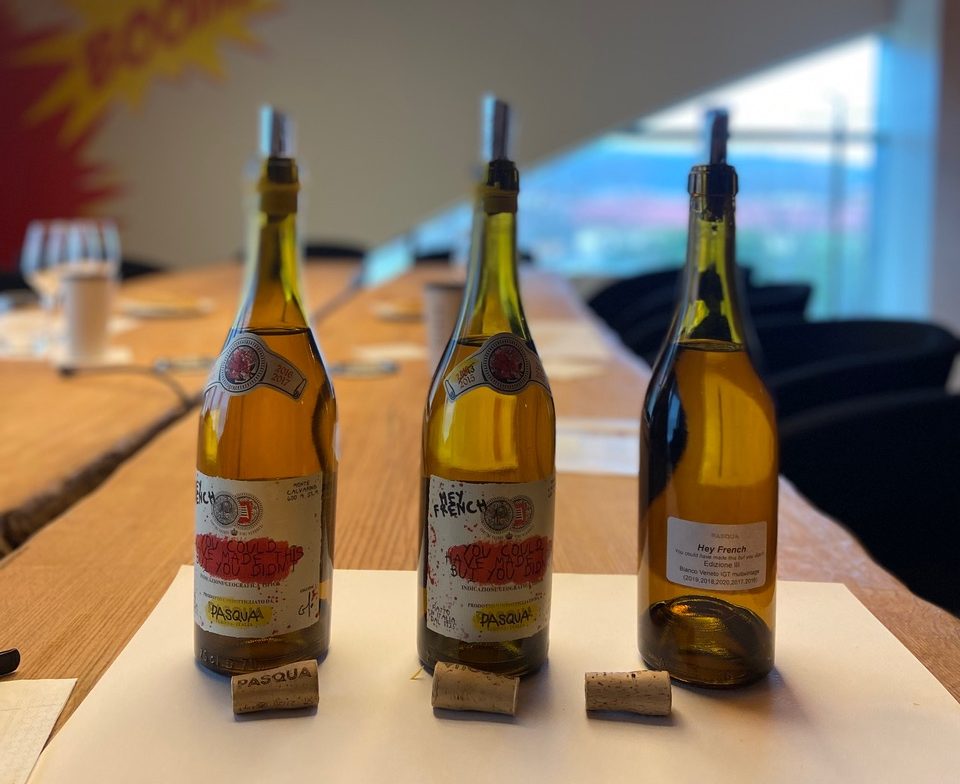
Hey French: You Could Have Made This But You Didn’t | First Edition
- VINTAGES: 2013-2015-2016-2017
- VARIETIES: 85% Garganega; 10% Sauvignon Blanc; 5% Pinot Blanc
- VINIFICATION: Blend of the 3 varieties during pressing, followed by 8 months of new barriques and new tonneau with a tiny percentage of malolactic fermentation. Each vintage is stocked in inox vats till the final blend, which took place in 2019 (two years after the last harvest).
- TASTING NOTES: This is the creamiest sample and not just because is the oldest, but it has always been showing this rounder, riper character with tons of perfumed dried fruit that Meursault hint of match head, some enticing exotic notes and a very velvet touch and yet a way higher acidity then expected. The wine is a true kaleidoscopic experience always changing at each turn of the glass .
Hey French: You Could Have Made This But You Didn’t | Second Edition
- VINTAGES: 2015-2016-2017-2018
- VARIETIES: 80% Garganega; 10% Sauvignon Blanc; 10% Pinot Blanc
- VINIFICATION: Blend of the 3 varieties during pressing, followed by 8 months in new barriques and new tonneau with a tiny percentage of malolactic fermentation. Here the 2018 didn’t go through any oak maturation. Each vintage is then stocked in inox vats till the final blend, which took place in 2020 (two years after the last harvest).
- TASTING NOTES: A sip of this wine reveals how the various blended vintages and varieties express a succession of smokier and greener notes in comparison to edition one. Less buttery notes and a greater expression of floral aromas and notes, combined with hints of chamomile, hazelnuts, citrus and tropical fruit. At one point when I left the glass there for a few minutes I got a more intense Sauvignon Blanc gooseberries and asparagus character soon to give way to a more subtle anice and peach flower finish.
Hey French: You Could Have Made This But You Didn’t | Third Edition
- VINTAGES: 2016-2017-2018-2019-2020
- VARIETIES: 80% Garganega; 10% Sauvignon Blanc; 10% Pinot Blanc
- VINIFICATION: Blend of the 3 varieties during pressing, followed by 30% New barrique and tonneaux for 8 months for the 2016 and the 2017 vintage (Basically no oak for the 2018, 2019 and 2020). The vintage percentage is 35% for the 2019; 25% for the 2018; 15% 2020; 15% 2017; 10% 2016, with the final blend being made in 2022 (two years after the last harvest)
- TASTING NOTES: As you might have noticed this edition has got 5 vintages instead of 4 and much less presence of the oak -with three vintages practically with no oak at all-. The result is a more monaurally driven wine with a fantastic gentian, and more official herbs, white peach, almond flowers and greater tension and acidity overall on the palate where the pencil shaving, the shiitake mushrooms notes are blending nicely with acacia flowers and honeydew melon.
Related news
Master Winemaker 100: Jesús Mendoza
Coterie-backed wine tech company raises nearly £1.1 million in crowdfunding

